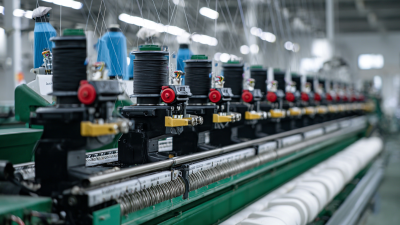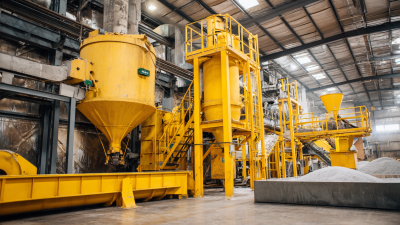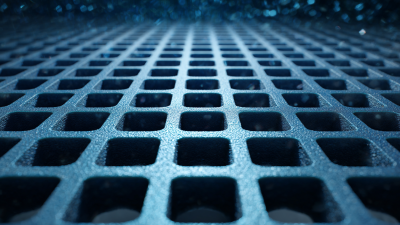Innovative Trends in Glass Fiber Industry at 2025 China Import and Export Fair with Market Insights
Table of Contents
- Innovative Applications of Glass Fiber in Emerging Industries
- Market Trends and Forecasts for Glass Fiber in 2025
- Sustainable Practices: Eco-Friendly Innovations in Glass Fiber Manufacturing
- Technological Advancements Driving Growth in Glass Fiber Sector
- Impact of Global Trade Policies on Glass Fiber Import and Export
- Networking Opportunities at the 2025 China Import and Export Fair
- Analyzing the Impact of Multi-Axial Warp Knitting Technology on Carbon Fiber Production Efficiency: Insights from 2023 Industry Reports
- FAQS
- Conclusion
- Related Posts
The glass fiber industry is really stepping up, and the recent 2025 China Import and Export Fair — also called the 138th Canton Fair — gave a pretty clear glimpse of where things are headed. Market growth is looking pretty solid, expected to grow around 6.5% each year, and that means there’s a huge jump in demand for new, innovative glass fiber products. You see this everywhere—construction, cars, even aerospace. Companies like DANYANG YIXUN MACHINERY CO., LTD are leading the charge here, with their focus on multiaxial and biaxial warp knitting machines, stitch bonding machines, and towel warp knitting equipment, all designed specifically for glass fibers and related textiles. These advancements are not just about making better products—they’re also in line with a worldwide push towards sustainability and lighter, more efficient materials. Looking at industry reports and current trends, it’s clear that the combo of tech innovation and market need is really shaping what the future of glass fiber applications will look like. Things are moving fast, and it’s pretty exciting to see where it all goes from here.

Innovative Applications of Glass Fiber in Emerging Industries
The glass fiber industry is really on the cusp of some exciting breakthroughs, especially as it finds new roles in emerging sectors. For example, the Fiberglass Fabric Market is expected to hit around USD 13.17 billion by 2029—that's a huge jump, and it signals that people are definitely looking for more advanced materials. A key focus right now is on creating sustainable and recyclable composites, which is a big deal since industries are increasingly leaning toward eco-friendly solutions. If you look at recent reports, you'll notice that automated and digital manufacturing methods are becoming more common—they’re helping boost efficiency and cutting down on environmental impact at the same time.
On top of that, we're seeing some pretty cool progress with lightweight composite structures, thanks to new manufacturing tech. This is really shaking things up in fields like aviation, automotive, and construction. There's also a noticeable move toward natural fiber composites—materials that are biodegradable and better for the environment. People love these because they’re renewable and generally require less energy to produce. As sustainable building materials become more popular, it’s clear that glass fiber is going to play a significant role in pushing performance standards higher and driving growth across multiple industries in the years ahead.
Market Trends and Forecasts for Glass Fiber in 2025
You know, the glass fiber industry is really on track to see some pretty amazing growth by 2025. It’s largely due to tech advances and a growing demand from all sorts of fields—think construction, automotive, and renewable energy. From what I’ve seen in recent market reports, the global glass fiber market might hit around $30 billion by 2025, with an annual growth rate of about 5% since 2020. What’s fueling this boom? Well, it’s mainly because these fibers are lightweight, resist corrosion, and are super strong—features that make them perfect for all kinds of innovative uses.
For businesses thinking about jumping into the glass fiber game, I’d really suggest focusing on sustainability. Using recycled materials or adopting eco-friendly manufacturing methods not only helps cut costs but can also make your brand more attractive to consumers who care about the environment.
Looking at the bigger picture, the Asia-Pacific region is definitely going to be leading the charge, thanks to fast-paced industrialization and urban growth. Countries like China and India are expected to take the spotlight, investing heavily in infrastructure projects. To stay competitive, companies should keep an eye on market trends and embrace new tech that can boost their production efficiencies.
Oh, and a little tip—watch out for shifts in the industries that end-users are in. Changes there can really shake up fiber prices and availability. Regularly checking market insights reports can help you plan better and avoid surprises in this ever-changing landscape.
Innovative Trends in Glass Fiber Industry at 2025 China Import and Export Fair with Market Insights - Market Trends and Forecasts for Glass Fiber in 2025
| Trends | Market Share (%) | Growth Rate (%) | Key Applications | Forecast Year |
|---|---|---|---|---|
| Eco-friendly Glass Fiber | 22% | 10% | Construction, Automotive | 2025 |
| High-Strength Glass Fiber | 18% | 8% | Aerospace, Sports Equipment | 2025 |
| Self-repairing Glass Fiber | 10% | 15% | Electronics, Marine | 2025 |
| Ultra-lightweight Glass Fiber | 15% | 12% | Transport, Wind Energy | 2025 |
| Functional Glass Fiber | 25% | 20% | Healthcare, Defense | 2025 |
Sustainable Practices: Eco-Friendly Innovations in Glass Fiber Manufacturing
So, at the 2025 China Import and Export Fair, the glass fiber industry is really stepping up to showcase some pretty exciting eco-friendly innovations. It’s all about sustainability these days, and manufacturers are putting more effort into greener tech than ever before. Honestly, this not only helps meet the rising demand for eco-conscious products but also creates some fresh opportunities to tap into new markets. By using recycled materials and cutting down on waste during production, companies aren’t just shrinking their carbon footprints — they’re also improving how durable and high-performing their glass fibers are.
One cool tip? Think about partnering up with local recycling centers to get recycled raw materials. It’s a smart move that can save costs and hits your sustainability goals at the same time. Also, upgrading to energy-efficient machinery can make a huge difference, reducing energy use and giving your company a greener edge.
And here’s the really exciting part: biodegradable glass fiber composites. These new materials aim to pack the same strength and versatility as traditional glass fibers but with the bonus of being eco-friendly. As manufacturers keep pushing forward with these kinds of innovations, it’s super important for everyone in the industry to stay updated and be ready to adapt. After all, staying competitive means keeping up with all these evolving trends.
Oh, and don’t forget — attending workshops and seminars during the fair can give you some pretty valuable insights into the latest green technologies. Plus, chatting with other industry folks is a great way to swap tips, share ideas, and push sustainability even further in glass fiber manufacturing. It’s an exciting time for the industry, and those who embrace these changes will definitely have an edge!
Technological Advancements Driving Growth in Glass Fiber Sector
The glass fiber industry is really going through some exciting technological changes right now, and it’s expected to see pretty significant growth by 2025. I recently came across a report from Market Research Future that predicts the global market for glass fibers could hit around USD 18 billion in just a couple of years, growing at about 5.5% annually since 2020. What’s driving this boost? Mainly, it’s the new and improved production methods—things that make the fibers stronger, more durable, and overall better performing. Plus, automated weaving and other high-tech manufacturing processes are making production faster and more accurate, which means glass fibers are becoming more popular for all sorts of uses, from aerospace projects to building construction.
On top of that, there’s a real shift towards more eco-friendly practices in the industry. Companies are now putting more effort into sustainable materials and recycling efforts. This is a response to growing environmental awareness among customers and new regulations alike. A report from Grand View Research points out that the demand for recycled glass fibers is expected to shoot up, possibly making eco-friendly glass fibers take up over 20% of the market in the next few years. All these technological advances combined with a stronger focus on sustainability really put the industry in a good spot for impressive growth in a fast-changing market.
Impact of Global Trade Policies on Glass Fiber Import and Export
As we get closer to the 2025 China Import and Export Fair, the glass fiber industry is definitely on the brink of some big shifts. A lot of this is because of the changing global trade policies, which can really shake up how glass fiber gets imported and exported. These policies can impact supply chains and how easily markets can access products — it’s a lot to keep up with! With stricter climate regulations and new tariffs coming into play, manufacturers are going to need to tweak their strategies if they want to stay competitive in such a connected, fast-moving world. Those companies that really prioritize compliance and sustainability are probably the ones who will find new doors opening for them, thanks to shifting global demand.

Tip: Keep an eye on international trade agreements and regulatory updates — these are game changers. Adjust your business plans accordingly so you can make the most of any new opportunities that come along.
On top of that, innovation is super important right now. Companies need to pour resources into R&D to develop lighter, tougher glass fiber products that meet the latest industry standards. Staying on top of market trends isn’t just about following the rules — it’s also about spotting chances to grow and stand out from the crowd.
Tip: Join industry groups or go to trade shows whenever you can. They’re great for picking up on market insights and meeting key players. Being proactive about this can help you predict changes and position your business to really thrive amidst global trade shifts.
Networking Opportunities at the 2025 China Import and Export Fair
The 2025 China Import and Export Fair is honestly one of those events where industry folks in the glass fiber world can really make meaningful connections, swap ideas, and explore new business opportunities. It’s a great place to meet a whole bunch of different people—manufacturers, suppliers, researchers—you name it. And honestly, building those relationships across different sectors can open up so many doors; it’s where innovative ideas get shared, cool new tech gets showcased, and everyone can get a pulse on the latest trends shaping the glass fiber scene.

Plus, it’s not just about formal networking. There are workshops and panel discussions too, which are an awesome way to learn from industry leaders, share challenges you’re facing, and maybe even brainstorm some solutions together. As global demand for glass fiber keeps climbing, this fair isn’t just a marketplace — it’s a real hub for creating strategic partnerships that could really boost growth and spark innovation in the years ahead. Honestly, it's one of those events you don’t want to miss if you’re serious about staying ahead in this industry.
Analyzing the Impact of Multi-Axial Warp Knitting Technology on Carbon Fiber Production Efficiency: Insights from 2023 Industry Reports
The advent of multi-axial warp knitting technology is revolutionizing the carbon fiber production landscape, as highlighted in the latest 2023 industry reports. This innovative technique enables the fabrication of multi-layer and multi-directional carbon fiber warp knitting fabrics, significantly enhancing efficiency and versatility in production. Designed for adaptability in various applications, machinery tailored for this technology can operate at impressive speeds ranging from 50 to 600 revolutions per minute. This flexibility allows manufacturers to meet diverse product specifications and cater to the increasing demand for high-performance materials.
The specifications of these machines are equally compelling, with widths available in 50 or 100 inches and gauge options of E5 and E6, making them suitable for a wide range of textile applications. Moreover, the incorporation of advanced weft-insertion devices further amplifies the capabilities of these machines, enabling the creation of complex fabric structures that were previously difficult to achieve. As the industry continues to embrace cutting-edge technologies, the integration of multi-axial warp knitting is poised to redefine the standards of production efficiency in carbon fiber manufacturing, ultimately leading to superior product performance and enhanced market competitiveness.
FAQS
: The Fiberglass Fabric Market is projected to reach USD 13.17 billion by 2029.
Key trends include the development of sustainable and recyclable composites, the integration of automated and digital manufacturing techniques, and the shift towards lightweight composite structures.
Technological advancements in production techniques are enhancing the mechanical properties and performance of glass fiber materials, driving growth and efficiency across various applications.
The industry is increasingly focusing on eco-friendly materials, recycling initiatives, and the production of natural fiber composites to address environmental concerns.
The global glass fiber market is projected to grow at a compound annual growth rate (CAGR) of 5.5% from 2020, reaching an estimated USD 18 billion by 2025.
The fair provides a platform for networking, idea exchange, and collaboration among stakeholders in the glass fiber industry, facilitating partnerships and discussions on emerging trends.
Natural fiber composites are favored for their environmental benefits, including biodegradability, renewable properties, and lower energy requirements in their production.
The market share for eco-designed glass fiber products is expected to increase by more than 20% due to rising demand for recycled glass fibers.
Manufacturers, suppliers, researchers, and other stakeholders in the glass fiber industry will benefit from the networking opportunities and knowledge exchange at the fair.
Advancements in glass fiber are revolutionizing sectors such as aerospace, automotive, and construction by enhancing material properties and production efficiency.
Conclusion
Hey, have you heard about the upcoming 2025 China Import and Export Fair? It’s gonna be pretty exciting because it’ll showcase some really cool innovations in the glass fiber world. They’re highlighting how versatile this stuff is, especially in these new and emerging sectors. For example, you'll see the latest on multiaxial and biaxial warp knitting machines—like those from DANYANG YIXUN MACHINERY CO., LTD—and how companies are leaning into more sustainable ways of doing things. It looks like the industry is heading for some serious growth, especially with tech advancements that make the products better and more efficient across different uses.
On top of all that, global trade policies are gonna play a big role. They could bring some hurdles but also open up new doors for manufacturers. The fair isn’t just about showing off new tech; it’s also a great chance for folks in the industry to network, team up, and share ideas—really pushing the sector forward. Overall, these changes show how important it is to stay adaptable and forward-thinking if we want to make the most of what glass fiber has to offer in the future markets. It’s definitely a space to watch!
Related Posts
-

7 Essential Tips for Choosing the Right Industrial Fabric for Your Projects
-

Unlocking Opportunities: Industrial Warp Knitting Machine Innovations at the 138th Canton Fair 2025
-

Unlocking Efficiency: Essential Strategies for Sourcing Spare Parts for Warp Knitting Machines
-

How to Optimize Your Production Line Efficiency with a Multifunction Batching Device
-

How to Master Warp Knitting Techniques for Unique Handmade Creations
-

Challenges Encountered with Glass Fiber Grille in Global Market


